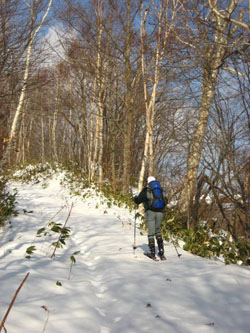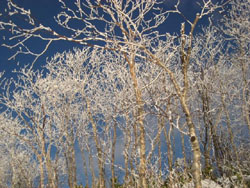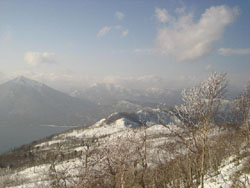Mountain skis offer a fun way to hike up and glissade down — but not if it's icy.
Snow season's not what it was . . .
By Mark Brazil | Jan 16, 2008
WINTERS ON THE WANE“Winter either bites with its teeth or lashes with its tail.” (Traditional proverb)
It’s cold, but I feel the warming rhythm of my pace developing as I get into my stride. There is a mountain ahead and I have set my mind on reaching the top.
At first, gray clouds billow, hiding the lake that lies off to the west. Forest trees stand stark, their frigid twigs like brittle fingers reaching for a sky they can sense beyond the cloud. As I hike higher the clouds drift apart, affording glimpses out over a stunning landscape: a volcanic cone, an ancient crater lake — and the mountain ahead. It’s no great peak, this Mount Monbetsu beside Lake Shikotsu here in Hokkaido, but it’s important to respect every mountain, especially in winter. Mountains have a knack of throwing unexpected weather at the unsuspecting hiker, and it’s always safest to be prepared for the worst.
On this occasion, on the last day of the old year, the worst was at the beginning. Within an hour the snow clouds that had seemed to hint that beating an early retreat might be in order gave way to the bright glare of sunshine on snow. Paraphrasing American painter Andrew Wyeth’s words: “I prefer autumn and winter, when you feel the bone structure of the landscape; something waits beneath it, hidden; the whole story doesn’t show.”
My sentiments exactly!
I’m warm now; rhythmic movement of legs and arms has sped circulation and I begin to sweat as I climb higher. But then the swish of my skis suddenly changes to a clatter as I hit ice, and only my sharp-tipped poles prevent a fall. The sudden change in surface breaks my reverie, and I realize that the powder snow I had expected to enjoy skiing back down on just isn’t there. Instead, an icy layer coats everything.
Two days earlier it had rained! In winters past, rain was unheard of in Hokkaido — rain fell only from spring to autumn; winter was snow season. But now, with the thermometer’s needle seemingly attached to a yo-yo, every few days the mercury rises above freezing, snow-packed roads thaw to a dangerous mush and precipitation is as likely to fall as rain as snow.
Snowflakes fall lightly like goose down, but the wetter they become the heavier and denser the snow layer. The extent of a winter’s snowfall, snow depth and texture vary from region to region, from valley to ridge, from one side of a mountain to the other — all these factors affecting the lives of organisms that can live with snow, or can only live without it.
When rain falls on snow it percolates through the upper coating, then freezes as a dense, hard, heavy layer forming a slippery barrier not merely to my mountain skis, but to creatures that burrow through or live beneath the snow. Each ice layer also represents a weakness in the snow that may trigger an avalanche later, bringing temporary devastation to the landscape and potential hardship to us humans and our structures in its path.
Skiing uphill on an icy snow crust brings every muscle into play to maintain balance; there are moments when falling seems inevitable; I realize that returning over the ice on skis will not be possible. Changes in snow and ice cover, changes in winter temperatures, the length and depth of winter — these are all about balance too.
In a human life we watch seasons come and go, shifting, changing, just as we watch the hands circle a clock face. For many organisms, however, their shorter lifespans mean that their lives tick past as quickly as the seasons change; their populations respond intimately to shifting temperatures. As winters warm and shorten, shorter-lived creatures can cram an extra generation into the year. Plants begin growth and flowering earlier in spring, set seed later in autumn, and species less able to weather cold winters are now able to push into areas that were once too harsh for them. But in doing so, they compete with species that were adapted to life in “snow country.”
Even in largely snowless Britain, resident birds are commencing their breeding seasons earlier and earlier, allowing some the chance of a second and even a third brood each year. Long-distance migrant birds find the going tougher though; their spring arrival and breeding previously coincided with peak local insect populations, but these too have responded to these warmed-up jump-started years and so reach their population peaks earlier. Past synchronization, as a result, gives way to present chaos.
Climate change is not merely about a warming Earth. It is like a hinge, swinging open a door to environmental issues, water issues, agricultural and forestry issues, and even to public health issues. Plants and insects are two enormous groups of organisms dependent on ambient temperatures. Unlike endothermic mammals, insects are ectothermic; their strategies in response to winter are either to flee (migration) or to hide (hibernation).
Insects tolerate freezing as cold-hardy adults or (as a species) by laying eggs that can survive winter beneath the soil or hidden in tree-bark crevices where, through “supercooling” the small amounts of water in their bodies can cool to as low as -38.1 degrees C without freezing. Others have evolved highly effective biochemistry using cryo-protectants to prevent ice formation in their cells.
Whatever their winter survival strategies, however, earlier endings of freezing weather gives insects a fantastic opportunity to become active and reproduce earlier. Consequently, many more insects are capable of becoming agricultural and forestry pests at great cost to those industries.
While fears of such insect depradations have focused on the likely spread of tropical diseases, such as malaria, into more temperate zones at great cost to health-care systems, more surprising have been outbreaks of unexpected viral infections in cold places, even during winter. Cold, snowy winters lead to many rodents hibernating, or at least adopting a subnivean lifestyle. Warmer winters with no snow cover across large areas of Russian farmland have, however, allowed rodent populations there to explode. Rodents carry serious hantaviruses, and as a consequence cases of deadly hemorrhagic fever with renal syndrome (HFRS) have seen a rapid increase. In other parts of the world, changing rainfall patterns have affected rodent populations — the consequences, though, have been the same: higher populations with greater risk of disease transmission to humans.
By the time I reached the top of Mount Monbetsu on skis, my faster-moving companions on snowshoes had set up our picnic. As I reflected on the season, and the view over the stunning Shikotsu-Toya National Park, I realized that my skis and their snowshoes were a kind of metaphor for future survival as our winters change. Skis serve as a more specialist style of winter outdoor equipment, allowing only certain types of motion over certain types of terrain. Snowshoes, in contrast, are generalist equipment — admittedly they provide no thrill from a long downward glissade, but their broad span, their snow- and ice-gripping treads and crampon-like teeth allow for access to much more of the back-country terrain.
Under changing conditions, specialized species — unable to manage under differing situations — lose out first. In their place, generalist species are able to shift and thrive, adapting quickly to changing conditions.
Last time I wrote that my personal excitement at the approach of winter is now tempered by the knowledge that it is a season in retreat. My sadness at the loss of winter is merely personal, but the ecological consequences are enormous. The white layer of snow and ice that spreads out each winter reflects sun energy back into space and, as winter whiteness is reduced, the darker areas of land and water absorb that energy instead. This leads to increases in average temperatures in a feedback loop that weakens winter further. Our world is now a rapidly changing one; our survival too will depend on our adaptability and flexibility — something well worth pondering from the next mountain peak!



